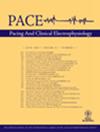心脏脉冲场消融系统设计的基础:安全性、有效性和可用性的优化。
IF 1.3
4区 医学
Q3 CARDIAC & CARDIOVASCULAR SYSTEMS
引用次数: 0
摘要
心脏脉冲场消融(PFA)系统的目标是为心律失常的治疗提供安全、有效和可用的治疗方法。实现这一目标是一项复杂的系统设计工作,需要优化导管、波形和剂量。这种优化通常是迭代的,因为在利用计算建模、台架测试、临床前动物研究和人类临床研究来评估系统性能的同时,需要平衡无数的设计因素来实现目标。对于工程师和临床医生来说,了解心脏PFA系统设计的基本原理是很重要的,以便合作不断提高这种扩展消融模式的性能。本文章由计算机程序翻译,如有差异,请以英文原文为准。
Fundamentals of System Design for Cardiac Pulsed Field Ablation: Optimization of Safety, Efficacy, and Usability.
The goal of a cardiac pulsed field ablation (PFA) system is to provide safe, effective, and usable therapy for the treatment of cardiac arrhythmias. Achieving this goal is a complex exercise in system design, requiring optimization of catheter, waveform, and dosing. This optimization is often iterative, as myriad design factors are balanced to achieve the goal while making use of computational modeling, bench testing, preclinical animal studies, and human clinical studies to evaluate system performance. It is important for both engineers and clinicians to understand the fundamentals of cardiac PFA system design in order to partner to continuously improve performance of this expanding ablation modality.
求助全文
通过发布文献求助,成功后即可免费获取论文全文。
去求助
来源期刊

Pace-Pacing and Clinical Electrophysiology
医学-工程:生物医学
CiteScore
2.70
自引率
5.60%
发文量
209
审稿时长
2-4 weeks
期刊介绍:
Pacing and Clinical Electrophysiology (PACE) is the foremost peer-reviewed journal in the field of pacing and implantable cardioversion defibrillation, publishing over 50% of all English language articles in its field, featuring original, review, and didactic papers, and case reports related to daily practice. Articles also include editorials, book reviews, Musings on humane topics relevant to medical practice, electrophysiology (EP) rounds, device rounds, and information concerning the quality of devices used in the practice of the specialty.
 求助内容:
求助内容: 应助结果提醒方式:
应助结果提醒方式:


